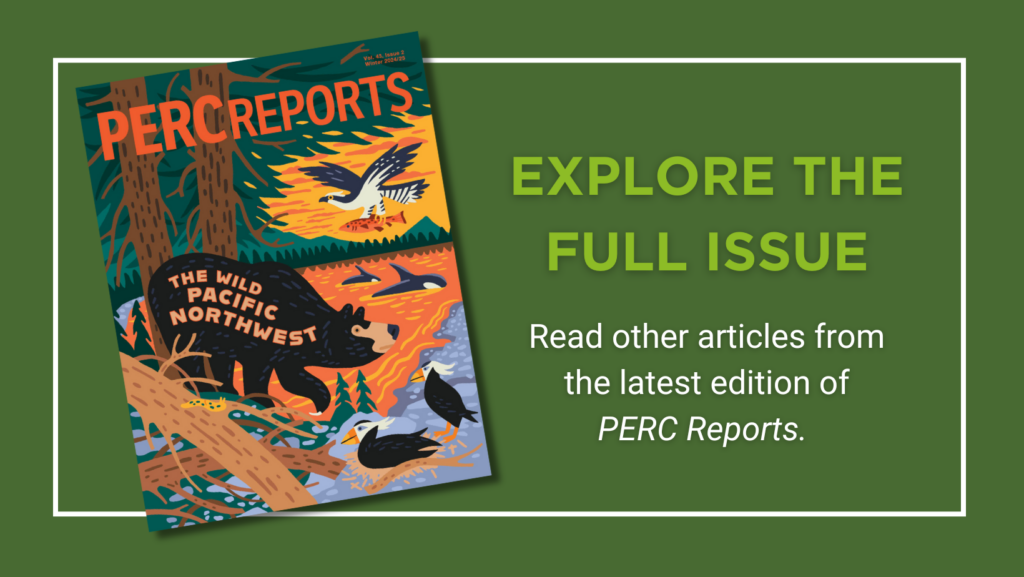

Virtual fencing in the land of Oz
Innovative ranchers have begun to trade barbed wire for invisible fences in parts of the American West. In Australia, a different type of virtual fencing is sparing kangaroos and other wildlife from vehicle collisions. The roadside system consists of devices mounted on posts spaced 25 meters apart. From dusk until dawn, headlights from passing automobiles trigger the devices, which emit a sound and flash LED lights. Animals seem to have associated the alerts with approaching vehicles, which used to kill approximately 250 kangaroos and wallabies each year along one 12-kilometer stretch where the technology has been installed. Now, in year three of the project, that figure has fallen by about half, suggesting that pushing the conservation frontiers of virtual fencing is worthwhile worldwide.
Mo’ mustangs, mo’ problems
A recently published study led by University of Wyoming scientists found that wild horses and sage grouse don’t always mix. “Over the last 20 years, free-roaming horse numbers have increased to more than three times the targeted goal across BLM lands,” said lead researcher Jeff Beck, “and this increase is one of the causes of sage grouse population declines.” The study, published in The Journal of Wildlife Management, monitored roughly 1,000 female sage grouse in central Wyoming over a 15-year period. It found that in places with incredibly abundant wild horse populations, nest and brood survival declined by up to 18 percent. The researchers concluded that “managing free-roaming horses at appropriate levels would be highly beneficial to sage grouse populations—and other species that rely on functioning sagebrush ecosystems.”


Rebates over regulation
A pilot program seeking to get hunters to voluntarily adopt non-lead ammunition was launched this past fall at seven National Wildlife Refuges. The aim is to use incentives—in this case, a reimbursement issued upon submitting proof of purchase of non-lead ammo—rather than mandates to change hunting behavior. Lead ammo is cheaper than alternatives and has been used by hunters in North America since European settlement, but fears about the effects of the toxic metal on wildlife persist. It has been banned for waterfowl hunting since the 1990s. On the last day of the Obama administration, the U.S. Fish and Wildlife Service sought to ban lead ammunition on all lands it manages, a move quickly reversed by the Trump administration. Now, the agency is experimenting with voluntary incentives—a welcome alternative to heavier-handed approaches.
Getting a fix
In September, the U.S. House of Representatives passed the “Fix Our Forests Act” in a decidedly bipartisan vote. The bill features several PERC priorities aimed at increasing the speed and scale of forest restoration on public lands. Among them are expanding Good Neighbor Authority, reforming rules around litigation that can unduly delay projects, and addressing the Cottonwood ruling that hinders on-the-ground land management by requiring federal agencies to navigate duplicative red tape. Policy Director Hannah Downey has testified in front of Congress in support of the bill, and PERC remains committed to working with the Senate on the package.


Underwater monitor
In British Columbia, the Wild Salmon Center is working with the Heiltsuk Nation to improve salmon research with artificial intelligence. It’s common for wildlife technicians posted on streams and rivers to monitor salmon and count them by hand as they return upstream to spawn. Accurate and up-to-date counts can be crucial to management decisions, such as when to close a harvest season to ensure enough fish make it upriver to spawn. So-called “Salmon Vision” technology incorporates underwater cameras and A.I. to count fish as well as identify their species and sex. The center, which works to protect rivers up and down the Pacific Coast, is aiming to eventually help additional First Nations in Canada collect better data to supplement existing research and optimize their salmon management.
Florida cat
It’s become standard in many western states to compensate ranchers for livestock lost to carnivores ranging from wolves to bears to mountain lions. Now, that strategy is moving east to conserve endangered Florida panthers, the official mammal of the Sunshine State. A three-year pilot funded by the National Fish and Wildlife Foundation is providing funds to compensate ranchers for livestock killed by the big cats. It will also offer financial incentives for property owners who make their land friendly to panthers. “Over half of Florida’s land area is private ownership,” says Tindl Rainey, director of conservation at the Fish and Wildlife Foundation of Florida. “So clearly, private landowners will play a critical role in wildlife and habitat conservation.” The big cat used to roam the Southeast, but only 100 to 200 Florida panthers remain today, confined to the southwestern part of the state. Programs like the ongoing pilot aim to boost the wild feline’s prospects by recognizing the costs imposed on ranchers and other landowners and working with them as collaborators in conservation.




